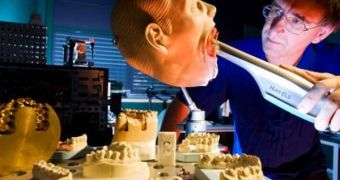At this point, dentists around the world have to engage in a very time-consuming process, when it comes to repairing their patients' teeth. They have to resort to molds and technicians to create a perfect mold of the teeth, so that it fits inside the mouth seamlessly. However, all that may soon be a thing of the past, as biting down on a silicon mold will be replaced by a 3D teeth-mapping technique, which will allow the dentists to take the most precise measurements of the inside of the mouth, and then recreate the teeth by using a computer, in which they insert the readings.
“The three-dimensional coordinates of the tooth surface can be determined on the basis of measurements taken in the patient's mouth,” Fraunhofer Institute for Applied Optics and Precision Engineering IOF 3-D measurement technology Group Manager Dr. Peter Kuhmstedt says. At this point, treating a patient involves making them bite a silicon mold, which is thus imprinted with the tooth mark. The indentations are then scanned using digital cameras, which allow a technician to recreate an exact model of the tooth. In the meantime, the patients are sent home, with temporary repairs, which may fail, leaving them in excruciating pain.
Now, the German researchers have managed to create an optical digitization system that scans the inside of the mouth and creates 3D representations of it. The device makes use of camera optics to collect all data, but one of the main problems that experts had while developing the new system was the fact that it wasn't very accurate if people moved while the photographs were taken. So, they made the process happen in a shorter amount of time. “The image sequence for each measurement position is captured in less than 200 milliseconds,” Kuhmstedt explains.
What allows the system to operate inside the mouth cavity is something called fringe projections, a process in which a strip of light is projected onto the area to be scanned. The shifts registered in the way the light shines are recorded by sensitive senors, which create a 3D image of the respective area. If the patient moves during that time, the strip of light may shine on other teeth, the tongue or the inside of the cheeks, causing the sensors to record erroneous data. In time, the new machine will help eliminate some of the pain associated with going to the dentist, the researchers hope.

 14 DAY TRIAL //
14 DAY TRIAL //